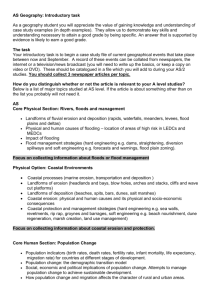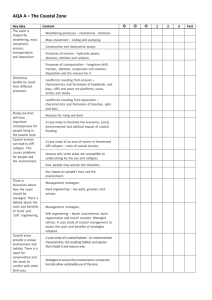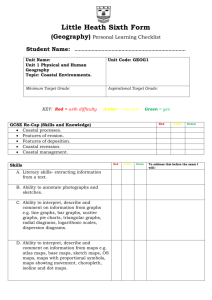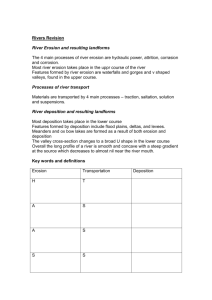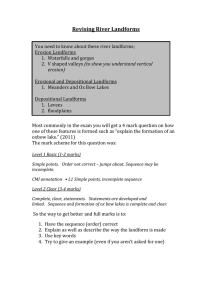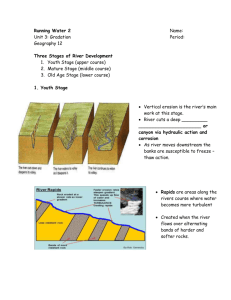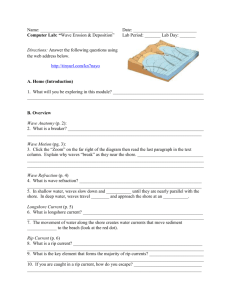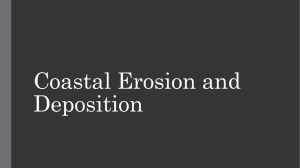Spec covered - geographylwc.org.uk
advertisement
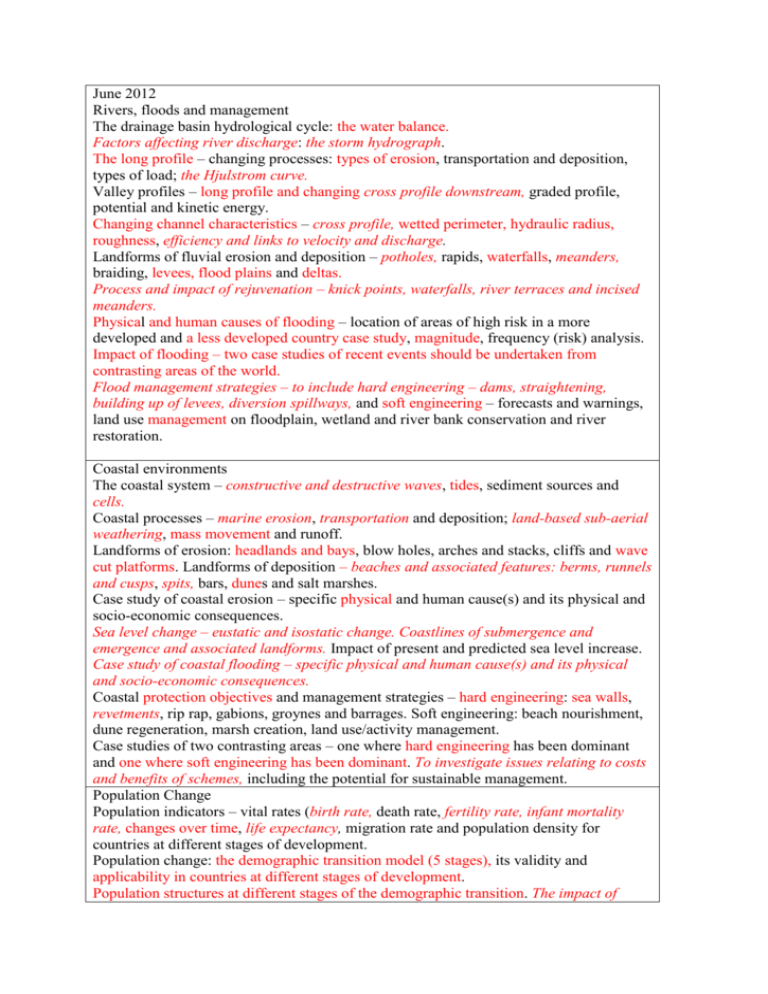
June 2012 Rivers, floods and management The drainage basin hydrological cycle: the water balance. Factors affecting river discharge: the storm hydrograph. The long profile – changing processes: types of erosion, transportation and deposition, types of load; the Hjulstrom curve. Valley profiles – long profile and changing cross profile downstream, graded profile, potential and kinetic energy. Changing channel characteristics – cross profile, wetted perimeter, hydraulic radius, roughness, efficiency and links to velocity and discharge. Landforms of fluvial erosion and deposition – potholes, rapids, waterfalls, meanders, braiding, levees, flood plains and deltas. Process and impact of rejuvenation – knick points, waterfalls, river terraces and incised meanders. Physical and human causes of flooding – location of areas of high risk in a more developed and a less developed country case study, magnitude, frequency (risk) analysis. Impact of flooding – two case studies of recent events should be undertaken from contrasting areas of the world. Flood management strategies – to include hard engineering – dams, straightening, building up of levees, diversion spillways, and soft engineering – forecasts and warnings, land use management on floodplain, wetland and river bank conservation and river restoration. Coastal environments The coastal system – constructive and destructive waves, tides, sediment sources and cells. Coastal processes – marine erosion, transportation and deposition; land-based sub-aerial weathering, mass movement and runoff. Landforms of erosion: headlands and bays, blow holes, arches and stacks, cliffs and wave cut platforms. Landforms of deposition – beaches and associated features: berms, runnels and cusps, spits, bars, dunes and salt marshes. Case study of coastal erosion – specific physical and human cause(s) and its physical and socio-economic consequences. Sea level change – eustatic and isostatic change. Coastlines of submergence and emergence and associated landforms. Impact of present and predicted sea level increase. Case study of coastal flooding – specific physical and human cause(s) and its physical and socio-economic consequences. Coastal protection objectives and management strategies – hard engineering: sea walls, revetments, rip rap, gabions, groynes and barrages. Soft engineering: beach nourishment, dune regeneration, marsh creation, land use/activity management. Case studies of two contrasting areas – one where hard engineering has been dominant and one where soft engineering has been dominant. To investigate issues relating to costs and benefits of schemes, including the potential for sustainable management. Population Change Population indicators – vital rates (birth rate, death rate, fertility rate, infant mortality rate, changes over time, life expectancy, migration rate and population density for countries at different stages of development. Population change: the demographic transition model (5 stages), its validity and applicability in countries at different stages of development. Population structures at different stages of the demographic transition. The impact of migration in population structure. The implications of different structures for the balance between population and resources. Social, economic and political implications of population change. Attempts to manage population change to achieve sustainable development with reference to case studies of countries at different stages of development. The way population change and migration affects the character of rural and urban areas. Settlement case studies – comparing two (or more) of the following areas – an inner city area, a suburban area, an area of rural/urban fringe and an area of rural settlement. To include reference to characteristics such as: housing, ethnicity, age structure, wealth and employment and the provision of services. The implications of the above for social welfare. Health Issues Global patterns of health, morbidity and mortality: health in world affairs. The study of one infectious disease (eg malaria, HIV/Aids), its global distribution and its impact on health, economic development and lifestyle. The study of one ‘disease of affluence’ (eg coronary disease, cancer), its global distribution and its impact on health, economic development and lifestyle. Food and health – malnutrition, periodic famine, obesity. Contrasting health care approaches in countries at different stages of development. Health matters in a globalising world economy –transnational corporations and pharmaceutical research, production and distribution; tobacco transnationals. Regional variations in health and morbidity in the UK. Factors affecting regional variations in health and morbidity – age structure, income and occupation type, education, environment and pollution. Age, gender, wealth and their influence on access to facilities for exercise, health care and good nutrition. A local case study on the implications of the above for the provision of health care systems.
